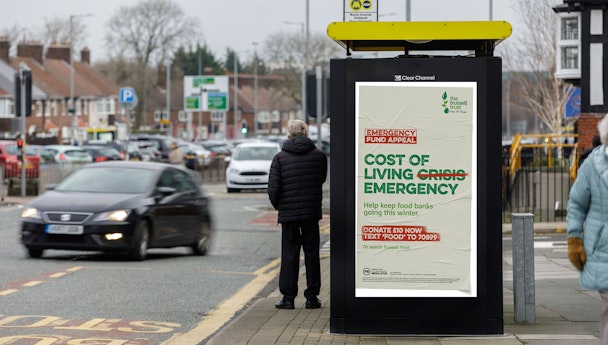What one food bank learned from its first foray into TV advertising?
Food banks are handing out an emergency parcel every 13 seconds. The UK’s biggest foodbank network urgently needed donations, so looked to TV to help.

The Trussell Trust is set to launch an emergency winter appeal
In July, the Trussell Trust launched its first-ever direct TV spot with Good Agency. As it prepares to release its Christmas campaign, we caught up with the charity to find out what it learned from its first-ever move into TV advertising.
Advertisement
The Trussell Trust faced a unique challenge in 2022 with demand for food parcels up 81%, but inflation was chipping away at people’s capacity to donate. Justin Wylie, associate director of public engagement at the Trussell Trust, says: “This gap between supply and demand is high. The need is there; it’s upsetting and it’s urgent.“
Before the direct response television (DRTV) campaign, the Trussell Trust had a diverse marketing mix, but Wylie says he needed to reach a wider audience. “TV was the most obvious way of creating something really authentic and conveying who we are to a mass audience.“
Topline results showed that the spot generated nearly 5,000 donations and garnered over 120m campaign impacts.
Since it was the charity’s first foray into TV, Wylie says it had to be squarely focused on the one campaign objective and not try to be too clever about it. That is why it chose a DRTV campaign, he explains – the “ad ashamedly asking for donations as that is what the external context demands.”
Pete Esuola-Grant, who is head of planning at Good, says the need for mass engagement meant the treatment needed to be in a simple and recognizable format. “We needed as many people as possible to give their support, so we used a traditional format that we knew would generate a response.”
Advertisement
Then there was also the need to create something that had longevity. “Unfortunately, the situation is going to be here for a while and is only going to get worse,” Esuola-Grant says. “Having a DRTV ad that can run and run means we can be ever-present and ever-relevant, and actually it’s only going to get more relevant as the crisis continues.”
Post-campaign, the Trussell Trust discovered that weekends were generally the “biggest volume drivers” and Saturday was the most cost-effective. Wylie says the charity has learned ads that used premium SMS generated better responses over SMS. He explains that “a large majority of SMS responders thought the text was donating or did not pick up the phone on a callback or refused to donate once called back.”
Contextual advertising also proved to be a successful tactic – for example, around a bulletin about food poverty on Sky News.
Suggested newsletters for you
More broadly, Wylie says: “Television is a channel that is working well for us. So far we have seen just under 5,000 donations, and therefore we intend to keep using this channel with a view to testing further so we can continue to refine and roll out best-performing channels, creatives and asks.
“I see this as a step into the TV and that was our whole plan – to open this up and reach a wider audience.”
The Trussell Trust and Good used all these lessons to inform the foodbank’s emergency Christmas appeal. Esuola-Grant says this is likely to be the network’s “toughest winter yet,” and the agency has been working with the Trussell Trust to “intensify” the messaging to best “reflect the scale of what the nation is facing.”

The latest campaign combines digital and direct mail, earned media, social, press inserts, press adverts, partially-addressed mail, display banners and out-of-home (OOH) activity. It borrows the ‘more than ever’ messaging from the DRTV spot. The winter appeal rolled out from November 15 and will run until the New Year.
Elsewhere, Wylie urges other charities that are looking to make their first steps with TV advertising to be clear on their ambition. “What are you trying to achieve and why are you going into it?”
Beyond that, he advises having a long-term plan for TV advertising. “You don’t want to see it as a one-off,” he says. “TV has to be right for you as an organization and the external context. It has to be a strategic fit.”

